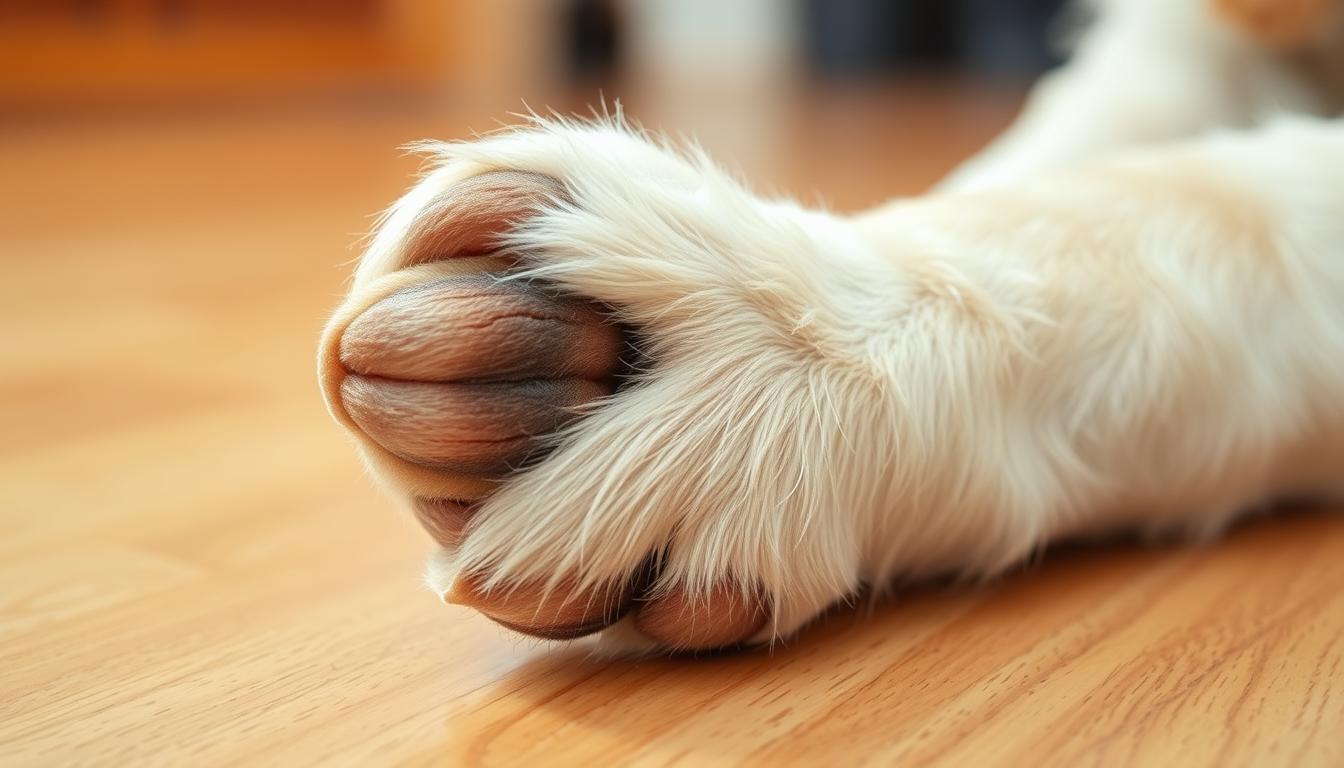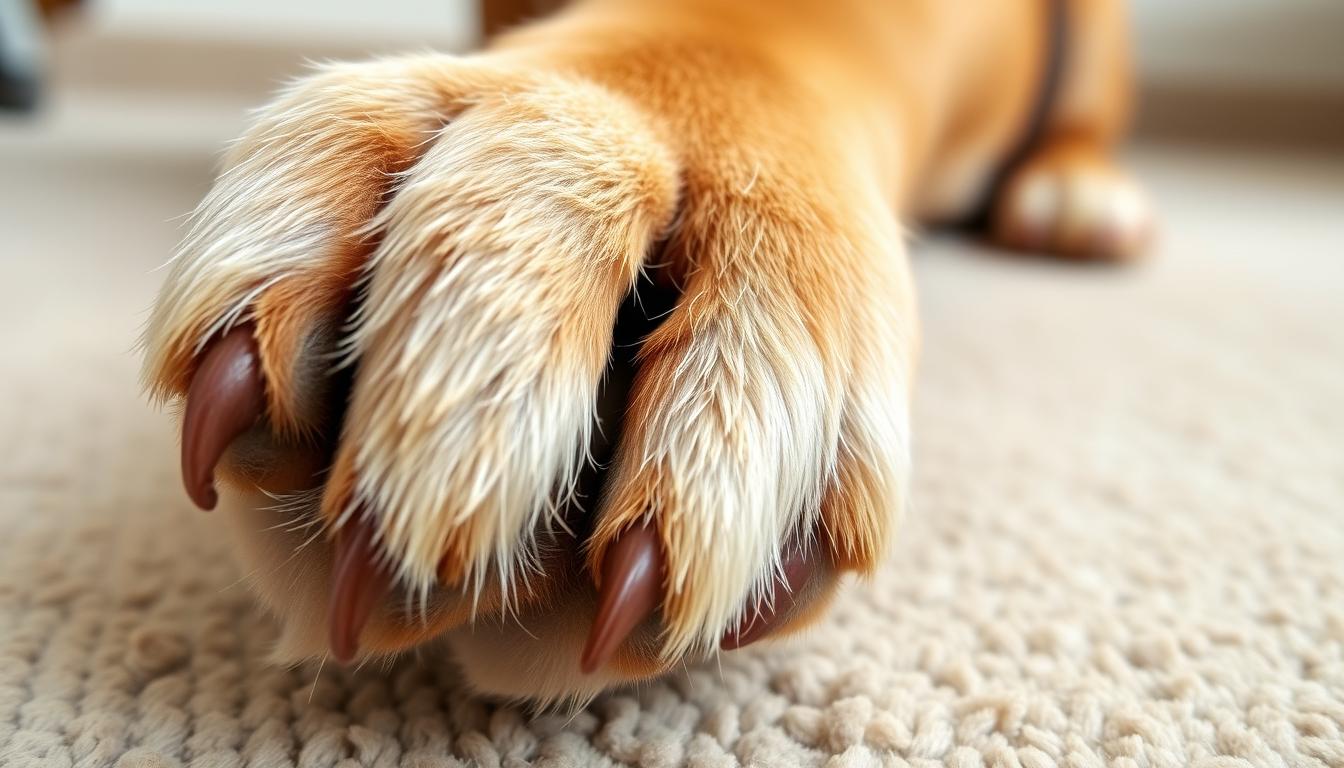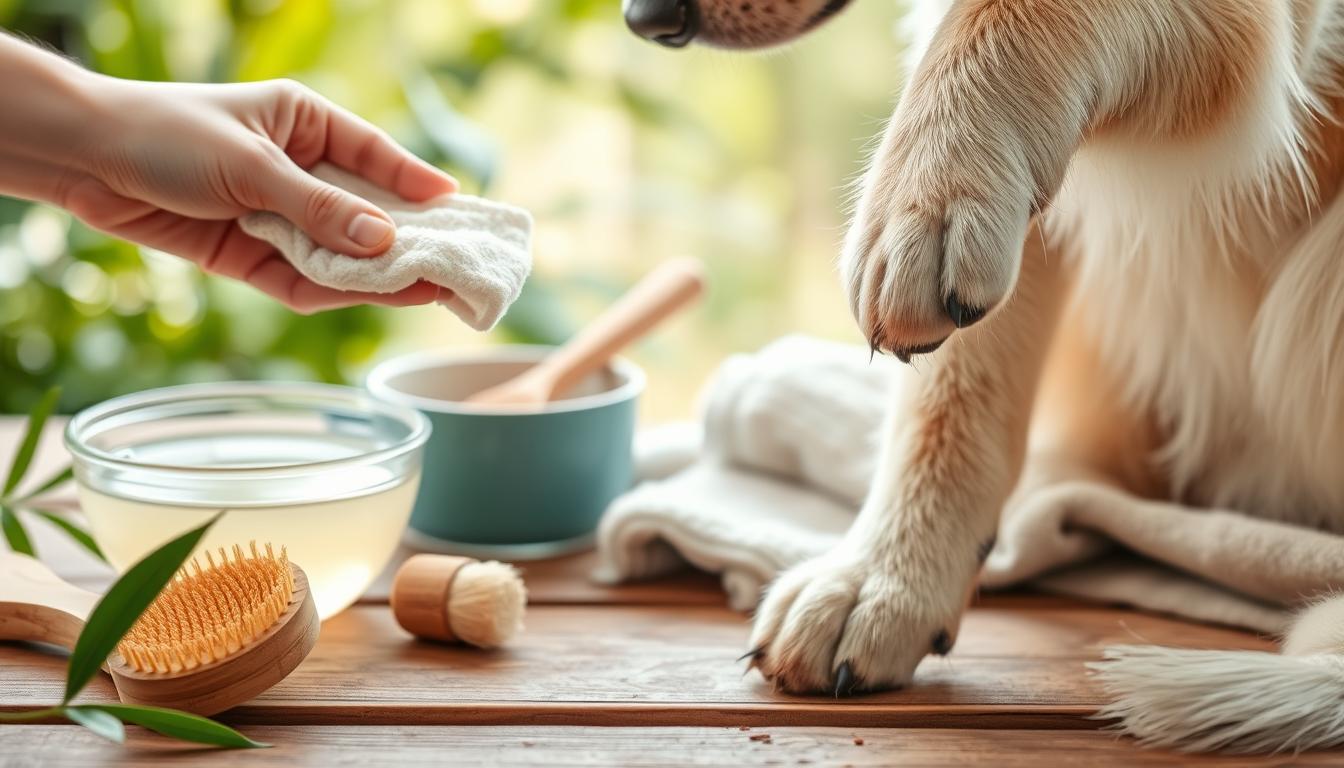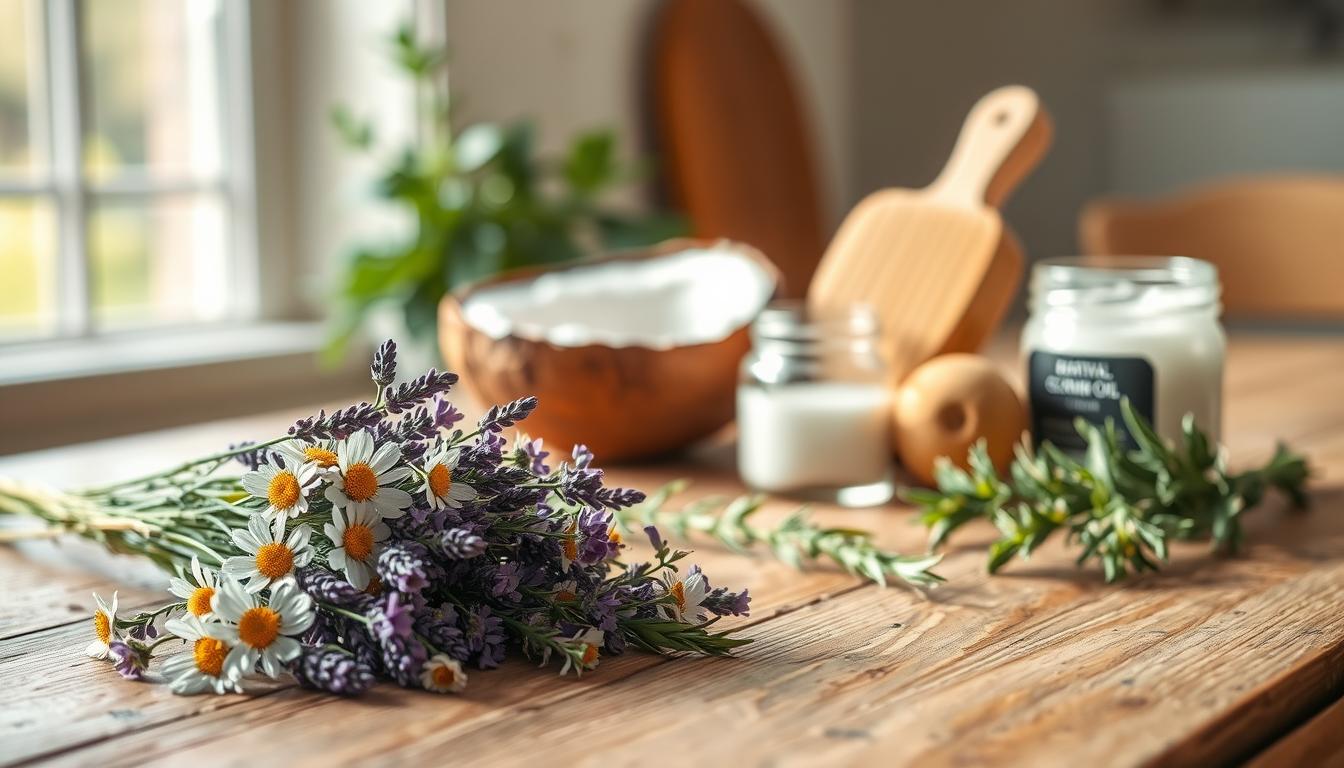
Welcome to a fresh perspective on maintaining your companion’s foot health! Whether your adventurous pet explores city sidewalks or muddy trails, their sensitive feet deserve safe, chemical-free care that aligns with their natural needs. This guide reveals simple solutions using household items you likely already own.
Traditional cleaning products often contain irritants that disrupt delicate paw pads. By contrast, natural methods protect your pet’s skin barrier while effectively removing dirt and allergens. You’ll discover how everyday ingredients like oatmeal and coconut oil can become powerful cleansing allies.
Our step-by-step system helps prevent common issues like cracked pads and bacterial infections. Regular maintenance using these techniques supports better mobility and comfort during walks. Best of all, you’ll reduce environmental impact without sacrificing cleanliness.
Key Takeaways
- Household items make effective, budget-friendly cleaning solutions
- Natural methods prevent skin irritation and dryness
- Regular care improves long-term paw health
- Eco-friendly approach benefits pets and the planet
- Builds positive associations with grooming routines
- Reduces tracking of outdoor contaminants indoors
Through this guide, you’ll master a routine that keeps those furry feet fresh and functional. Let’s explore how to create a stress-free cleaning experience that strengthens your bond with your four-legged friend.
Introduction: Why Clean Dog Paws Matter

Your pet’s feet interact with countless surfaces daily, making proper care essential. What many owners don’t realize is that those adorable toe beans act like sponges, absorbing whatever they touch during outdoor adventures.
Guardians of Wellness
Neglected feet become breeding grounds for trouble. Microscopic invaders like bacteria thrive in warm paw pads, while sharp debris can create hidden wounds. Regular inspections during cleaning sessions help catch issues early – think of it as preventive healthcare for your companion.
Winter brings unique challenges. Ice-melting chemicals cling to fur, potentially causing burns if not removed. Summer heat can bake pavement residues into sensitive skin. Each season demands attention to different threats lurking between those fuzzy toes.
Home Defense Strategy
Ever wonder why your floors stay gritty despite constant sweeping? Those four-legged vacuum cleaners bring outdoor particles indoors with every step. A quick wipe-down routine reduces allergens and keeps your living spaces fresher.
Consider this: every park visit deposits invisible hitchhikers on your pet’s feet. From lawn treatments to urban pollutants, these unwelcome guests don’t belong in your kitchen. Simple post-walk care creates cleaner play areas for both two-legged and four-legged family members.
Understanding the Importance of Natural Paw Care
Maintaining healthy feet starts with understanding their unique needs. Our companions walk on surfaces ranging from scorching asphalt to chemical-treated grass, making protective care non-negotiable. Gentle approaches preserve the skin’s moisture balance while addressing environmental challenges.

Preventing Hidden Health Threats
Daily inspections transform routine care into infection prevention. Veterinary assistant Pamela Payne emphasizes:
“Check between toes and pads after every outing. Tiny cuts become gateways for harmful bacteria if ignored.”
Natural cleansers soothe rather than strip protective oils, creating an unfavorable environment for pathogens.
Harsh products disrupt pH levels, leading to cracked skin and discomfort. Gentle alternatives like chamomile rinses reduce redness while cleaning thoroughly. This approach minimizes allergic reactions common with synthetic ingredients.
Spotting Trouble Early
Watch for these signs during paw checks:
- Unusual licking or chewing behaviors
- Visible swelling between toes
- Changes in pad texture or color
Seasonal allergens often manifest as inflamed skin. Natural balms with calendula or shea butter create protective barriers against irritants. Persistent issues like recurring sores or limping warrant professional evaluation to prevent complications.
Building trust through gentle handling makes examinations easier over time. Pets who associate paw care with positive experiences remain calmer during vet visits. Remember – healthy feet support joyful adventures and peaceful naps alike.
Preparing for a Natural Cleaning Routine
Creating an effective paw care regimen begins with smart preparation. The right tools and environment turn maintenance into a bonding experience rather than a chore. Let’s explore how to assemble your toolkit and create a stress-free zone for your furry friend.

Essential Tools and Supplies
Quality matters when selecting materials for sensitive foot care. Veterinarian-approved wet wipes remove debris without drying skin. Always use separate sections for each foot to prevent spreading germs.
| Item | Purpose | Usage Tip |
|---|---|---|
| Pet-safe wipes | Quick debris removal | One wipe per foot |
| Dexas MudBuster | Deep cleaning | Rotate clockwise |
| Oatmeal shampoo | Muddy situations | Dilute in warm water |
| Microfiber towel | Thorough drying | Pat gently |
Portable solutions like silicone-bristled cleaners work wonders after park visits. Keep a designated water bowl for foot baths – never reuse kitchenware. “Consistency in tools helps pets recognize grooming as routine,” notes groomer Lisa Tanaka.
Setting Up a Safe Cleaning Environment
Choose a quiet area with non-slip flooring for stability. Position all supplies within arm’s reach:
- Absorbent towels folded nearby
- Pre-measured shampoo portions
- Temperature-checked water
Rubber mats prevent slips during watery cleanups. Always test water warmth with your elbow first. Finish sessions with praise and treats to build positive associations. With these preparations, you’ll transform paw care from struggle to snuggle time.
How to clean dog paws naturally: A Step-by-Step Guide
Keeping those furry feet fresh starts with a methodical yet soothing cleaning process. Follow this sequence to address both visible dirt and hidden concerns while maintaining your companion’s comfort.

Gentle Cleansing Essentials
Begin by rinsing each foot with warm water to soften hardened mud and dissolve salt residues. Veterinary assistant Pamela Payne advises:
“Lukewarm temperatures work best – test it on your wrist first.”
Use your fingers to massage between pads, dislodging trapped particles without irritating sensitive skin.
Inspect carefully while washing. Look for pebbles in crevices or grass seeds clinging to fur. These common hitchhikers can cause infections if overlooked. For stubborn debris, soak feet briefly in a shallow basin before wiping.
Post-Cleaning Protection
After rinsing, apply a diluted antiseptic made for animals using cotton pads. Focus on areas between toes where moisture lingers. Never use human products – their formulas often contain harmful alcohols.
Pat dry with absorbent towels, paying special attention to webbed areas. Finish with a light mist of pet-safe antibacterial spray if needed. This creates a protective barrier against urban pollutants during your next walk.
Consistent care prevents cracked pads and reduces tracking dirt indoors. Remember – calm handling and tasty rewards turn necessary grooming into bonding moments your furry friend might actually enjoy!
Home Remedies and Natural Ingredients
Transform everyday household items into paw care essentials that combine effectiveness with gentle care. The right combination of natural solutions and proper tools makes maintenance both practical and enjoyable for your furry companion.

DIY Antiseptic and Natural Soaps
Apple cider vinegar solutions work wonders for removing grime without harsh chemicals. Mix one part vinegar with three parts water for a pH-balanced rinse. Certified vet tech Mara Simmons notes:
“This mixture helps dissolve road salt while maintaining skin’s natural acidity.”
Create herbal infusions using chamomile or calendula flowers. Steep two tablespoons in warm water for 15 minutes, then strain. These plant-based cleansers reduce inflammation while tackling dirt.
For muddy adventures, try oatmeal-based mixtures. Grind plain oats into powder and mix with coconut oil for a scrub that exfoliates gently. Rinse thoroughly to avoid residue between toes.
Using Towels, Wipes, and Grooming Aids
Designate specific wipes for each foot to prevent cross-contamination. Look for biodegradable options with aloe vera – they remove pollen effectively while moisturizing pads. Rotate wipe corners to maximize cleaning surfaces.
Microfiber towels outperform regular terry cloth by absorbing 7x their weight in moisture. Use patting motions rather than rubbing to protect delicate skin. Always check between toes – trapped dampness here causes 80% of paw infections.
| Tool | Best Use | Frequency |
|---|---|---|
| Silicone brush | Mud removal | After walks |
| Bamboo wipes | Quick cleanups | Daily |
| Hemp towel | Final drying | Each wash |
Establish a post-walk ritual: treats during wiping create positive associations. For pups resistant to handling, start with brief sessions using extra-soft cloths. Consistency turns necessary care into cherished bonding time.
Integrating Regular Paw Care into Your Routine
Consistent care transforms occasional maintenance into lifelong wellness habits. By weaving foot care into daily activities, you create predictable patterns that benefit both you and your companion. This approach reduces stress while ensuring those adventurous feet stay healthy through every season.

Building Predictable Patterns
Begin foot checks immediately after returning from walks. Young animals adapt fastest – puppies who experience gentle handling grow into adults comfortable with inspections. Choose a specific spot near your entryway for this daily ritual, keeping supplies organized and accessible.
Timing matters. Schedule sessions when your four-legged friend is naturally calmer, like after meals or playtime. Certified trainer Alex Rivera suggests:
“Pair the routine with a verbal cue like ‘Paw time!’ to create clear expectations.”
Positive Reinforcement Strategies
Immediate rewards work best. Offer small, low-calorie treats during and after each successful session. For energetic companions, spread peanut butter on a silicone mat to keep them occupied while you work.
Adjust techniques based on weather needs – snowy days might require longer rinses, while summer walks need quick pollen removal. Always end interactions with praise or a favorite game. Over time, these moments become cherished parts of your shared day rather than chores.
| Challenge | Solution | Benefit |
|---|---|---|
| Resistance to handling | Lickable treats | Distracts while working |
| Busy schedules | Pre-packed wipes by door | Saves time |
| Multiple pets | Color-coded towels | Prevents mix-ups |
Precautions and When to Seek Veter
While natural care works wonders, recognizing limits protects your furry friend’s well-being. Discontinue any method causing redness or discomfort, even if ingredients seem harmless. Some companions develop sensitivities to plant-based solutions over time.
Watch for persistent licking, unusual odors, or swollen pads – these often signal deeper issues. Cracks that bleed or discolored nails warrant professional evaluation. “Bacterial infections spread quickly between toes,” warns Dr. Ellen Park of Animal Wellness Clinic. “Early intervention prevents costly treatments later.”
Emergency signs include sudden limping, excessive heat in feet, or refusal to walk. Chemical burns from road treatments may require prescription ointments. Always keep your vet’s contact handy and share your cleaning routine during check-ups.
Remember: Natural approaches complement – but don’t replace – medical expertise. Trust your instincts if something seems off. With mindful observation and timely care, you’ll keep those adventurous feet ready for miles of happy explorations.
FAQ’s
Why is cleaning my dog’s feet important for their health?
Dirt, salt, or chemicals stuck between paw pads can cause irritation or infections. Regular care prevents issues like cracked skin and keeps your pup comfortable.
Can I use household items like vinegar for paw care?
Yes! Diluted apple cider vinegar (1:1 with water) works as a gentle antiseptic. Avoid harsh chemicals—opt for natural soaps like castile or oatmeal-based brands like Earthbath.
Should I check for injuries during cleaning?
Always inspect pads for cuts, thorns, or debris. Gentle wiping with a soft cloth helps spot problems early. If you find wounds, consult your veterinarian.
What’s the best way to handle dirty pads after walks?
Rinse with warm water to remove grime, then pat dry with a clean towel. For quick cleanups, use biodegradable wipes like Burt’s Bees for Pets.
How do I soothe irritated pads naturally?
Try a lukewarm oatmeal soak or aloe vera gel (pet-safe). Avoid human lotions—they can cause more irritation. Coconut oil also moisturizes dry skin.
How often should I clean their feet?
After every walk, especially in snowy or muddy weather. Daily checks help prevent long-term issues. Make it a fun routine with treats!
When should I contact a vet about paw problems?
If your pet limps, licks excessively, or has redness/swelling, seek professional care. Persistent odor or discharge could signal infections needing treatment.
Also Read:


